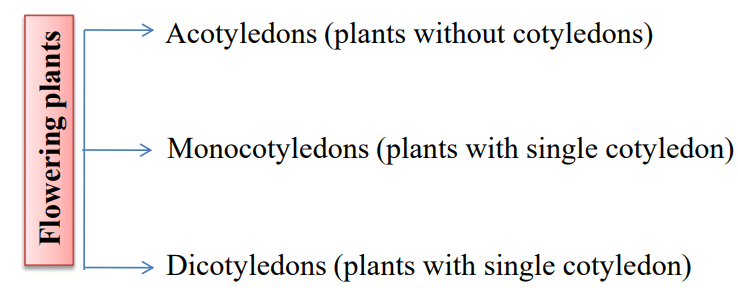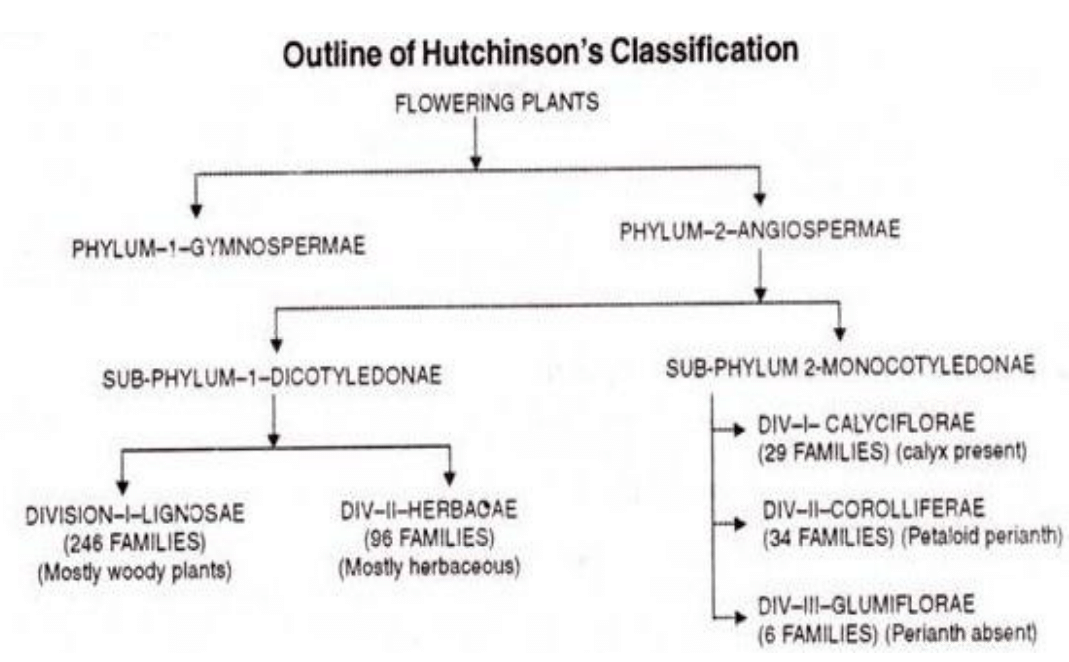UPSC Exam > UPSC Notes > Botany Optional for UPSC > Origin and Evolution of Angiosperms
Origin and Evolution of Angiosperms | Botany Optional for UPSC PDF Download
Classification of Angiosperm
Artificial system of classification
Artificial system of classification is an early method of categorizing plants based on easily observable, superficial characteristics. It was primarily developed during the 17th and 18th centuries. One of the key contributors to this system was John Ray, an English naturalist.
Here are some key points about the artificial system of classification:
- Basis of Classification: This system relies on external features such as plant habit (whether a plant is a herb, shrub, or tree) and the number of cotyledons (seed leaves).
- John Ray's Contribution: John Ray's book "Methods Plantarum Nova" (1682) is one of the foundational works in this classification system. He was the first to divide plants into two major groups based on cotyledon number: dicotyledons (plants with two seed leaves) and monocotyledons (plants with one seed leaf).
- Carolus Linnaeus: Another prominent figure in this system is Carolus Linnaeus, who classified plants based on the number, union, and length of stamens. He developed a classification system that included 24 classes and categorized around 7,300 plant species.
- Simplicity: The artificial system was relatively simple and relied on easily observable characteristics. It served as an important starting point for organizing the vast diversity of plant life.
- Limitations: However, the artificial system had limitations. It did not reflect the evolutionary relationships between plants, and it sometimes led to inconsistencies when classifying plants with diverse features.
Natural system of classification
- A.L. de Jussieu (1748-1836) developed a natural classification system for plants in his book "Genera Plantarum secundus ordines Naturales Disposita." He categorized all plants into 15 classes, further divided into 100 orders (now referred to as families). His criteria for classification included the number of cotyledons, the number of petals, and the arrangement of petals. His categories included Acotyledons (plants without cotyledons), Monocotyledons (plants with a single cotyledon), and Dicotyledons (plants with two cotyledons), focusing on flowering plants.

- A.P. de Candolle (1778-1841), a French botanist, published "Theorie elementaire de la Botanique," where he classified approximately 58,000 species into 161 families. He divided plants into two main groups: cellulares (non-vascular plants) and vasculares (vascular plants).
- George Bentham (1800-1884) and Dalton Hooker (1817-1911), British taxonomists, formulated one of the most renowned natural classification systems, known as "Bentham and Hooker's Classification." They meticulously documented detailed descriptions of most known plants of their time in the monumental work "Genera Plantarum," published in three volumes between July 1862 and April 1883.
Salient Features of Bentham and Hooker’s classification
- This classification system focuses exclusively on "seed plants" or phanerogams.
- Bentham and Hooker documented a total of 97,205 species of seed plants, categorized into 7,569 genera within 202 families. Their classification spans from the Ranunculaceae family to the Poaceae family.
- They divided all seed plants into three main groups or classes: Dicotyledons (comprising 165 families), gymnosperms (including 3 families), and monocotyledons (encompassing 34 families).
- The classification includes orders that were considered disputed or difficult to place satisfactorily, which were grouped as Ordines Anomali.
- Monocotyledons were described in this system after the dicotyledons.
- Within the dicotyledons, they further divided the group into three Divisions: Polypetalae, Gamopetalae, and Monochlamydeae. Each division is further divided into 14 series. Each series is then subdivided into cohorts, which correspond to modern orders, and cohorts are further divided into orders, which correspond to modern families.
- In the Monochlamydeae division, major taxa, such as series, were distinguished based on whether the plants had terrestrial or aquatic habits.
- Polypetalae includes 82 families, 2,610 genera, and 31,874 species. Gamopetalae comprises 45 families, 2,619 genera, and 34,556 species. Monochlamydae consists of 36 families, 801 genera, and 11,784 species. Similarly, Monocotyledons encompass 34 families, 1,495 genera, and 18,576 species.
Overview of Bentham and Hooker Classification

Merits of Bentham and Hooker’s System
- Each plant in the system has been meticulously described, either from real specimens or preserved herbarium sheets. As a result, the descriptions are highly detailed and accurate.
- This classification system is highly practical and serves as a valuable tool for students studying systematic botany, facilitating the straightforward identification of species.
- The botanical flora included in the system provides information about the geographical distribution of species and genera, enhancing our understanding of plant distribution.
- The descriptions of genera are thorough, precise, and based on direct observations, ensuring the accuracy of the classification.
- Larger genera have been subdivided into subgenera, each containing a specific number of species, which helps in organizing and categorizing diverse plant groups.
- The inclusion of Ranales at the beginning of dicots is significant, as these are now universally recognized as some of the most primitive angiosperms.
- Placing monocots after dicots in the system aligns with evolutionary trends and is a natural arrangement based on the development of plant characteristics.
- The positioning of series disciflorae between thalami florae and calyciflorae is logical and reflects natural relationships within the plant kingdom.
- Placing gamopetalae after polypetalae is justified, as it reflects the evolutionary advancement of petals from a free condition to a fused or united state.
Demerits of Bentham and Hooker’s System
- The placement of gymnosperms between dicots and monocots is unconventional and does not align with the evolutionary relationships among these groups.
- The subclass monochlamydeae is considered somewhat artificial, lacking clear natural affinities among its included families.
- Positioning monochlamydeae after gamopetalae may not reflect a natural sequence in the evolution of plant characteristics.
- Some closely related species are separated in this system, while distantly related species are grouped together, which can be a source of confusion.
- Certain families within monochlamydeae share close affinities with families in polypetalae, such as Chenopodiaceae and Caryophyllaceae, suggesting that the system may not accurately represent evolutionary relationships.
- The classification places advanced families like Orchidaceae near the beginning of monocotyledons, which may not reflect their true evolutionary status, as Orchidaceae is one of the most advanced monocot families. Similarly, Compositae (Asteraceae) is placed near the beginning of gamopetalae, which is considered unnatural.
- The separation of Liliaceae and Amaryllidaceae is based solely on ovary characteristics, even though they are closely related, indicating that the system relies on some arbitrary criteria.
- Bentham and Hooker's classification lacks phylogenetic considerations, meaning it doesn't take into account the evolutionary history and genetic relationships among plant groups.
Phylogenetic Systems of classification
Phylogenetic classification is a system that categorizes organisms based on their evolutionary features and genetic relationships.
Some important phylogenetic systems include:
- Engler and Prantl Classification (1884-1930): Engler and Prantl published a comprehensive classification in 23 volumes known as "Die Naturlichen Pflanzenfamilien." They organized flowering plants based on the increasing complexity of their floral morphology. In their system, they considered monocots as more primitive than dicots.
- John Hutchinson (1884-1972): Hutchinson authored "Families of Flowering Plants" in two volumes and served as the director of the Royal Botanic Garden in Kew, England. His classification system was based on 24 fundamental principles and is widely followed. Hutchinson's system places monocots after dicots in the evolutionary sequence.

The document Origin and Evolution of Angiosperms | Botany Optional for UPSC is a part of the UPSC Course Botany Optional for UPSC.
All you need of UPSC at this link: UPSC
|
179 videos|143 docs
|
Related Searches















